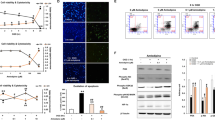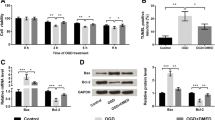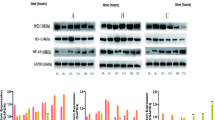Abstract
It is known that diabetes hyperglycemia enhances cerebral ischemia and reperfusion induced damage. We have previously shown that mutation of inner mitochondrial membrane peptidase 2-like (IMMP2L) increases brain damage caused by transient cerebral ischemia. In this study, we attempt to examine the impact of IMMP2L deficiency on an in vitro model that mimics the diabetic hypoxic conditions. Normal IMMP2L wild type and IMMP2L gene deleted HT22 cells were cultured. Hypoxia was induced under high glucose and acidic conditions with 4 h of oxygen deprivation. Cell viability was assessed by CCK-8 assay and cell death was determined using Annexin V/7-AAD assay. Superoxide production was measured using dihydroethidium staining and mitochondrial membrane potential was detected using JC-1 probe. Suppression of IMMP2L reduced the cell viability, increased the ROS production and decreased the mitochondrial membrane potential. In conclusion, our study demonstrated that deficiency of IMMP2L in cells, cultured under hypoxia, high glucose and acidic conditions, exacerbated neuronal death under a condition that mimics in vivo cerebral ischemia in diabetic condition.






Similar content being viewed by others
References
Rickhag M, Deierborg T, Patel S, Ruscher K, Wieloch T (2008) Apolipoprotein D is elevated in oligodendrocytes in the peri-infarct region after experimental stroke: influence of enriched environment. J Cereb Blood Flow Metab 28(3):551–562. doi:10.1038/sj.jcbfm.9600552
Liang S, Wang XL, Zou MY, Wang H, Zhou X, Sun CH, Xia W, Wu LJ, Fujisawa TX, Tomoda A (2014) Family-based association study of ZNF533, DOCK4 and IMMP2L gene polymorphisms linked to autism in a northeastern Chinese Han population. J Zhejiang Univ Sci B 15(3):264–271. doi:10.1631/jzus.B1300133
Bertelsen B, Melchior L, Jensen LR, Groth C, Glenthoj B, Rizzo R, Debes NM, Skov L, Brondum-Nielsen K, Paschou P, Silahtaroglu A, Tumer Z (2014) Intragenic deletions affecting two alternative transcripts of the IMMP2L gene in patients with Tourette syndrome. Eur J Hum Genet 22(11):1283–1289. doi:10.1038/ejhg.2014.24
Patel C, Cooper-Charles L, McMullan DJ, Walker JM, Davison V, Morton J (2011) Translocation breakpoint at 7q31 associated with tics: further evidence for IMMP2L as a candidate gene for Tourette syndrome. Eur J Hum Genet 19(6):634–639. doi:10.1038/ejhg.2010.238
Gimelli S, Capra V, Di Rocco M, Leoni M, Mirabelli-Badenier M, Schiaffino MC, Fiorio P, Cuoco C, Gimelli G, Tassano E (2014) Interstitial 7q31.1 copy number variations disrupting IMMP2L gene are associated with a wide spectrum of neurodevelopmental disorders. Mol Cytogenet 7:54. doi:10.1186/s13039-014-0054-y
Han C, Zhao Q, Lu B (2013) The role of nitric oxide signaling in food intake; insights from the inner mitochondrial membrane peptidase 2 mutant mice. Redox Biol 1:498–507. doi:10.1016/j.redox.2013.10.003
Soler R, Fullhase C, Lu B, Bishop CE, Andersson KE (2010) Bladder dysfunction in a new mutant mouse model with increased superoxide–lack of nitric oxide? J Urol 183(2):780–785. doi:10.1016/j.juro.2009.09.074
Guimaraes-Souza NK, Yamaleyeva LM, Lu B, Ramos AC, Bishop CE, Andersson KE (2015) Superoxide overproduction and kidney fibrosis: a new animal model. Einstein (Sao Paulo, Brazil) 13(1):79–88. doi:10.1590/s1679-45082015ao3179
Lu B, Poirier C, Gaspar T, Gratzke C, Harrison W, Busija D, Matzuk MM, Andersson KE, Overbeek PA, Bishop CE (2008) A mutation in the inner mitochondrial membrane peptidase 2-like gene (Immp2l) affects mitochondrial function and impairs fertility in mice. Biol Reprod 78(4):601–610. doi:10.1095/biolreprod.107.065987
Ma Y, Mehta SL, Lu B, Li PA (2011) Deficiency in the inner mitochondrial membrane peptidase 2-like (Immp21) gene increases ischemic brain damage and impairs mitochondrial function. Neurobiol Dis 44(3):270–276. doi:10.1016/j.nbd.2011.06.019
Cytometers A (2009) Analysis of mitochondrial membrane potential. http://www.biotechniques.com/protocols/Cytometry/Flow_Cytometry/Analysis-of-mitochondrial-membrane-potential/biotechniques-181008.html. Accessed Nov 2009. doi:10.2144/000113278
Peng LA, Juurlink BH, Hertz L (1991) Differences in transmitter release, morphology, and ischemia-induced cell injury between cerebellar granule cell cultures developing in the presence and in the absence of a depolarizing potassium concentration. Brain Res Dev Brain Res 63(1–2):1–12. doi:10.1016/0165-3806(91)90061-M
Cronberg T, Rytter A, Asztely F, Soder A, Wieloch T (2004) Glucose but not lactate in combination with acidosis aggravates ischemic neuronal death in vitro. Stroke 35(3):753–757. doi:10.1161/01.str.0000117576.09512.32
Dempsey RJ, Baskaya MK, Combs DJ, Donaldson D, Rao AM, Prasad MR (1996) Effect of hyperglycemia on reperfusion-associated recovery of intracellular pH and high energy phosphates after transient cerebral ischemia in gerbils. Neurol Res 18(6):546–552. doi:10.1080/01616412.1996.11740468
Stecker MM, Stevenson M (2015) Effects of pH on the response of peripheral nerve to anoxia. Int J Neurosci 125(3):221–227. doi:10.3109/00207454.2014.922971
Xu X, Jiang H, Liu H, Zhang W, Xu X, Li Z (2012) The effects of galanin on dorsal root ganglion neurons with high glucose treatment in vitro. Brain Res Bull 87(1):85–93. doi:10.1016/j.brainresbull.2011.10.012
Gaelzer MM, Santos MS, Coelho BP, de Quadros AH, Simao F, Usach V, Guma FC, Setton-Avruj P, Lenz G, Salbego CG (2016) Hypoxic and Reoxygenated Microenvironment: Stemness and Differentiation State in Glioblastoma. Mol Neurobiol. doi:10.1007/s12035-016-0126-6
Yu J, Maimaitili Y, Xie P, Wu J, Wang J, Yang Y, Ma H, Zheng H (2016) High glucose concentration abrogates sevoflurane postconditioning cardioprotection by advancing mitochondrial fission but dynamin-related protein 1 inhibitor restores these effects. Acta Physiol (Oxf). doi:10.1111/apha.12812
Wu N, Shen H, Liu H, Wang Y, Bai Y, Han P (2016) Acute blood glucose fluctuation enhances rat aorta endothelial cell apoptosis, oxidative stress and pro-inflammatory cytokine expression in vivo. Cardiovasc Diabetol 15(1):109. doi:10.1186/s12933-016-0427-0
Liu L, Zhang R, Liu K, Zhou H, Yang X, Liu X, Tang M, Su J, Dong Q (2009) Tissue kallikrein protects cortical neurons against in vitro ischemia-acidosis/reperfusion-induced injury through the ERK1/2 pathway. Exp Neurol 219(2):453–465. doi:10.1016/j.expneurol.2009.06.021
George SK, Jiao Y, Bishop CE, Lu B (2011) Mitochondrial peptidase IMMP2L mutation causes early onset of age-associated disorders and impairs adult stem cell self-renewal. Aging cell 10(4):584–594. doi:10.1111/j.1474-9726.2011.00686.x
George SK, Jiao Y, Bishop CE, Lu B (2012) Oxidative stress is involved in age-dependent spermatogenic damage of Immp2l mutant mice. Free Radic Biol Med 52(11–12):2223–2233. doi:10.1016/j.freeradbiomed.2012.04.003
Tsujimoto Y, Shigeomi S (2007) Role of the mitochondrial membrane permeability transition in cell death. Apoptosis 12(5):835–840. doi:10.1007/s10495-006-0525-7
Christophe M, Nicolas S (2006) Mitochondria: a target for neuroprotective interventions in cerebral ischemia-reperfusion. Curr Pharm Des 12(6):739–757. doi:10.2174/138161206775474242
Sims NR, Muyderman H (2010) Mitochondria, oxidative metabolism and cell death in stroke. Biochim Biophys Acta 1802(1):80–91. doi:10.1016/j.bbadis.2009.09.003
Li J, Yu W, Li XT, Qi SH, Li B (2014) The effects of propofol on mitochondrial dysfunction following focal cerebral ischemia-reperfusion in rats. Neuropharmacology 77:358–368. doi:10.1016/j.neuropharm.2013.08.029
Liao J, Ye Z, Huang G, Xu C, Guo Q, Wang E (2014) Delayed treatment with NSC23766 in streptozotocin-induced diabetic rats ameliorates post-ischemic neuronal apoptosis through suppression of mitochondrial p53 translocation. Neuropharmacology 85:508–516. doi:10.1016/j.neuropharm.2014.06.008
Kroemer G, Galluzzi L, Brenner C (2007) Mitochondrial membrane permeabilization in cell death. Physiol Rev 87(1):99–163. doi:10.1152/physrev.00013.2006
Leung AW, Halestrap AP (2008) Recent progress in elucidating the molecular mechanism of the mitochondrial permeability transition pore. Biochim Biophys Acta 1777(7–8):946–952. doi:10.1016/j.bbabio.2008.03.009
Ryu SY, Peixoto PM, Teijido O, Dejean LM, Kinnally KW (2010) Role of mitochondrial ion channels in cell death. Biofactors 36(4):255–263. doi:10.1002/biof.101
Bharadwaj MS, Zhou Y, Molina AJ, Criswell T, Lu B (2014) Examination of bioenergetic function in the inner mitochondrial membrane peptidase 2-like (Immp2l) mutant mice. Redox Biol 2:1008–1015. doi:10.1016/j.redox.2014.08.006
Acknowledgements
This study was supported by National Natural Science Foundation of China (Grant Nos. 81360196, 81660229) and Study Abroad Returnees Science Foundation of Ningxia Province (Grant No. 20146).
Author information
Authors and Affiliations
Corresponding author
Ethics declarations
Conflict of interest
The authors declare that they have no conflict of interest.
Additional information
Yi Ma and Zijing Zhang contributed equally to this study, they are co-first authors.
Rights and permissions
About this article
Cite this article
Ma, Y., Zhang, Z., Chen, Z. et al. Suppression of Inner Mitochondrial Membrane Peptidase 2-Like (IMMP2L) Gene Exacerbates Hypoxia-Induced Neural Death Under High Glucose Condition. Neurochem Res 42, 1504–1514 (2017). https://doi.org/10.1007/s11064-017-2207-y
Received:
Revised:
Accepted:
Published:
Issue Date:
DOI: https://doi.org/10.1007/s11064-017-2207-y




